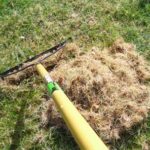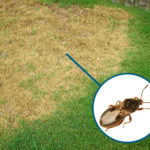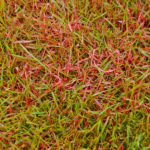Your poor pup might be taking all the blame, but the truth is those yellow spots in your yard can occur whether or not you even own dogs.
 There’s no arguing that your dog’s pee contains nitrogen that, when released onto the ground, can cause a yellow mark to appear due to an excess in the micronutrient. But that does not necessarily mean you need to find a way to lower the nitrogen levels in your dog’s urine. Nitrogen is a beneficial (and essential) element for the soil, and a healthy yard should be able to properly absorb, distribute, and utilize it. If your lawn is covered in these patches, it might mean your grass is sick and in need of your help.
There’s no arguing that your dog’s pee contains nitrogen that, when released onto the ground, can cause a yellow mark to appear due to an excess in the micronutrient. But that does not necessarily mean you need to find a way to lower the nitrogen levels in your dog’s urine. Nitrogen is a beneficial (and essential) element for the soil, and a healthy yard should be able to properly absorb, distribute, and utilize it. If your lawn is covered in these patches, it might mean your grass is sick and in need of your help.
So let’s bring your yard back to a lush and green existence! By following these five steps, your lawn should reach a healthful state that is able to maintain a beautiful appearance despite the weather, bugs… and dog pee.
Our 5 Steps to a New Healthy Lawn
Step 1 – Remove Unwanted Material From Lawn
Before doing anything else, you will want to get rid of any sickly, dead, or unwanted organic material. This includes sticks, dog poop, and of course weeds.
Weed control products may be necessary if you have large areas that are overgrown. All weeds must be completely removed as any roots left behind will begin to hog all the nutrients that is surely needed to feed your grass. Just Be Careful! Most likely your pets will not be allowed in the yard for some time after a weed killer has been applied. Please follow the directions closely.
Before moving on, it is also a good idea to investigate those lawn burns and make sure it’s not one of the following grass disorders:
 Thatch
ThatchWhat may look like dead patches throughout your yard could actually be thatch, a thin layer of dead roots, grass and other plants that accumulate on top of the ground’s surface. Thatch will form when the normal decomposition of loose grass clippings and general plant debris cannot break down fast enough often due to compacted soil. You will want to remove all of the excessive thatch with a dethatching rake or similar tool.
Photo courtesy of eartheasy.com
 Chinch bug infestation
Chinch bug infestationWhen thatch exists, it is soon followed by chinch bugs as it makes an ideal breeding ground for them. Once they have infiltrated your yard, chinch bugs will suck on the blades of grass while injecting a toxin, gradually killing off your lawn. It may look like burn spots, or as if you’re going through a drought; but on closer inspection you may find microscopic bugs feeding away. Sometimes even the naked eye isn’t able to confirm their existence and a professional opinion may be needed. If chinch bugs are the diagnosis, you will most likely need to apply an insecticide to remedy the issue.
 Red Thread Lawn Disease
Red Thread Lawn DiseaseHave you ever seen red coloring on the very tips of your grass? This is indicative of Red Thread Lawn Disease, a disorder caused by the fungus Laetisaria fuciformis, often occurring during periods of wet weather and/or a poor drainage system.. Red Thread Disease is in no way related to your dog’s bathroom habits, and in fact is more likely to occur when a lawn is lacking nitrogen.
If you do begin seeing red tips, you will want to take care of this as soon as possible as it can spread fast. Although several fungicides are readily available in stores, our secret ingredient is neem oil. Not only can neem oil quickly cure Red Thread Disease, but it can further protect your lawn by warding off insects that try to feed off of it. And yes, neem oil is safe for dogs, just follow the safety instructions on the bottle.
Photo courtesy of lawn-craft.co.uk
Step 2 – Aeration
One of the most common reasons for a sickly lawn is compact soil. Compact soil is when the soil grains become so close together that the pore space is drastically reduced restricting water and air from entering to surface and reaching down to the roots. Compaction will inevitably happen over time, especially in a backyard heavily used by humans ad animals. In order to solve this issue, you will need to aerate the ground – meaning perforating the surface in order to re-expose the soil to the air. There are two main types of aerating tools exist – a spike aerator and a plug aerator.
 Spike Aerator
Spike AeratorSpike aerators poke tiny holes into the ground’s surface with the intent to make water move more freely into the soil. This is the more popular item purchased by residential consumers – and who can blame them? It’s light-weight, easy to use, and can fit in most residential sheds. Unfortunately, some things are too good to be true. In reality, spike aerators are mostly ineffective since the holes are so small and shallow, and in many cases can cause further compaction soon after the first rainfall.
 Core/Plug Aerator
Core/Plug AeratorCore aerators remove much larger and deeper clumps (a.k.a. plugs) of soil (about 2 – 3 inches deep, 0.5 – 0.75 inches in diameter) to ensure deep-rooted exposure to oxygen, water and nutrients for an extended period of time. The one downside is how substantially larger it is compared to a spike aerator. About the size of a riding mower, plug aerators can weigh at least 250 pounds, and cost a few thousand dollars to own. Still being the better option, you might want to rent this device (if you think you can handle the heavy machine yourself) or hire a company that will do it for you. If you happen to own a riding mower, you may want to look into purchasing a more affordable plug aerating device that you can tow behind as you ride it.
Photo courtesy of mowersatjacks.com
How often should you aerate? Different soil types require varied frequencies of aeration. Clay soil, commonly found in the United States, compacts easily and should be aerated at least once per year. . A sandy soil may only need to be aerated once every other year. If you are set on having a beautiful healthy lawn, our best recommendation is aerate twice a year in the spring and fall right around when you would want to fertilize.
Step 3 – Fertilize
Next you will want to feed your lawn with fertilizer in order to nourish it with the proper nutrients it is in dire need of. There are two main types of fertilizers out there: Quick-release and Slow-release.
Quick-release fertilizers are water-soluble and therefore immediately available to your plant’s roots when applied;you’ll see almost immediate growth of your grass. The downside is that since the nutrients are absorbed so quickly, you will need to be re-apply on a more frequent basis. Quick-release fertilizers are a danger to your pet since it can be absorbed through their skin. You will need to wait an extended period of time before letting them out after application. Read the directions closely!
Slow-release fertilizers are made to be water insoluble using special organic material or a protective coating. The nutrients are released gradually over time meaning less applications. Although you will need to wait a little longer to see the results, slow-release fertilizers are the safer option in order to avoid further burning your lawn.
 One of our favorite fertilizers is Milorganite – a slow-release fertilizer that is made from nutrient-fed microbes that are kiln dried at temperatures exceeding 900 F, ensuring all pathogens are killed off, making it safe for dogs (and you). The result is an effective fertilizer with a 5% Nitrogen content. The low nitrogen level might mean you need to lay down more but it promotes a more even spread and thus a more even growth.
One of our favorite fertilizers is Milorganite – a slow-release fertilizer that is made from nutrient-fed microbes that are kiln dried at temperatures exceeding 900 F, ensuring all pathogens are killed off, making it safe for dogs (and you). The result is an effective fertilizer with a 5% Nitrogen content. The low nitrogen level might mean you need to lay down more but it promotes a more even spread and thus a more even growth.
We recommend to fertilize twice a year, right after you aerate.
Step 4 – Seeding
 Seeding, more specifically overseeding, is the planting of grass seeds directly into your existing turf. It can be used to regrow bare spots, improve the overall density of your lawn, and restore your yard’s appearance to that vivid green color you once knew.
Seeding, more specifically overseeding, is the planting of grass seeds directly into your existing turf. It can be used to regrow bare spots, improve the overall density of your lawn, and restore your yard’s appearance to that vivid green color you once knew.
You do not necessarily need to plant the same type of grass that was there before, but it’s important to pick one that is right for your climate as well as how much sun your yard is exposed to.
Here is a quick guide on grass seeds – from TractorSupply.com
(W) = warm season grass (C) = cool season grass
| Type of Grass | Drought Resistance | Need for Water | Texture | Traffic Level | Sun | Other Features |
|---|---|---|---|---|---|---|
| Bahia (W) | High | Low | Coarse | High | Full sun to partial shade | Moderately aggressive |
| Bermuda (W) | High | Medium | Fine to Medium | High | Full sun | Fills in quickly |
| Buffalo (W) | High | Low | Fine | High | Full sun | Requires minimal maintenance |
| Centipede (W) | Medium | Medium | Coarse | Low | Full sun to partial shade | Creeps low to the ground, slow growing |
| Creeping Bent Grass(C) | Low | High | Fine | High | Full sun to partial shade | Found on golf courses; provides carpet-like lawn |
| Fescue (C) | High | Low | Coarse | Medium | Full sun to partial shade | Many varieties; thrives in mild winters/warm summers |
| Kentucky Blue Grass (C) | Medium | Medium to high | Fine to medium | Medium to high | Full sun to partial shade | Withstands cold and is resistant to disease |
| Perennial Ryegrass (C) | Low | High | Medium to coarse | Medium to high | Full sun to partial shade | Intolerant of extreme heat or cold |
| St. Augustine (W) | Low to medium | Medium to high | Coarse | Medium | Full sun to partial shade | Grows quickly |
| Zoysia (W) | Medium to high | Medium | Fine to medium | High | Full sun to partial shade | Dense and wiry |
If you are in Pet Poo Skiddoo’s hometown state of North Carolina, the most popular grasses used are fescue (tall or thin), Kentucky bluegrass, and Perennial ryegrass.
Other Buying Considerations:
Avoid straight seed. Straight seed products only contain one type of grass, which actually makes it more vulnerable to drought and disease. By buying a seed blend or mixture, you are combing the beneficial attributes of several different grass types, strengthening its overall resistance. A good blend blend will group together grasses with the same season type.
Germination vs weed. Not every single seed will be successful, but check the label and make sure the chance of germination is above 75% and weed contamination is lower than 0.5%.
 Drop Spreader. We highly recommend a drop spreader in order to ensure an even spread and avoid creating concentrated piles of seeds. Overabundant seedlings can result in inconsistencies as the seeds are forced to fight over the resources available in the soil. Often the seed’s packaging will list settings to use for the spreading device.
Drop Spreader. We highly recommend a drop spreader in order to ensure an even spread and avoid creating concentrated piles of seeds. Overabundant seedlings can result in inconsistencies as the seeds are forced to fight over the resources available in the soil. Often the seed’s packaging will list settings to use for the spreading device.
Overseeding should be performed twice per year, and can be spread on top of fresh fertilizer.
Step 5 – Water
 You may have heard that you should water the spot right after your dog pees. Although that will help, it’s hard to imagine following your dog around with a watering can as he looks for a place to do his business. What might be a better option and certainly more practical is to start watering your entire lawn on a regular basis so that it is always well hydrated and prepared to properly distribute the dog’s urine as it reaches the soil.
You may have heard that you should water the spot right after your dog pees. Although that will help, it’s hard to imagine following your dog around with a watering can as he looks for a place to do his business. What might be a better option and certainly more practical is to start watering your entire lawn on a regular basis so that it is always well hydrated and prepared to properly distribute the dog’s urine as it reaches the soil.
Water is a key factor in keeping your plants healthy and allowing the natural process of photosynthesis to take place. While mammals (including us) are made up of 70% water, plant life contains 90% water, hence will require more H2O to continue thriving.
It may differ on the type of climate or time of year, but on average you will want to give your grass 1-1.5” inches of water on a weekly basis. This equates to all areas receiving 20-30 minutes of irrigation 3 times a week (of course this can be lessened if it has rained). You should try to water during the cooler part of the day like from 6-10am or 4-7pm. Make sure the ground is completely dry before applying water again.
It is important to note you’ll need to water more -at least once a day – after laying down seed in order to have them germinate. Straw can be layered on top to help lock in the moisture. This aggressive watering will last 1-4 weeks depending on the type of seed and your environment until the grass reaches three inches tall.
If you start seeing puddles or suspect your lawn is being oversaturated, you may need to improve your drainage system by installing perforated tubing or a french drainage system.
 Droughts are a big problem across much of the country these days, and many are hesitant to water their grass due to fear of water shortages (not to mention high water bills). To reduce your water usage, it would still be a good idea to invest in a rain barrel to collect water when it rains and use that supply rather than taking from your town’s water supply.
Droughts are a big problem across much of the country these days, and many are hesitant to water their grass due to fear of water shortages (not to mention high water bills). To reduce your water usage, it would still be a good idea to invest in a rain barrel to collect water when it rains and use that supply rather than taking from your town’s water supply.
Photo courtesy of goodideasinc.com
If after following all five steps, you are still experiencing yellow spotting, there are a few more things to consider:
 Lawn repair mixes may be necessary for areas where your dog tends to urinate the most. Lawn repair mix can help rejuvenative grass by using a scientifically balance of mulch, seeds and fertilizer with the advantage of having it all in one pre-mixed convenient bag. This should only be done after the five steps have been applied and you have waited the correct amount of time for the grass to grow.
Lawn repair mixes may be necessary for areas where your dog tends to urinate the most. Lawn repair mix can help rejuvenative grass by using a scientifically balance of mulch, seeds and fertilizer with the advantage of having it all in one pre-mixed convenient bag. This should only be done after the five steps have been applied and you have waited the correct amount of time for the grass to grow. Consider alternatives to grass. There are several way to rework the design of your lot to incorporate less grass. Places like California and Las Vegas who are more prone to droughts are known for having beautiful desert landscapes that require little water for upkeep. There’s also the art of mulching that can cover a lot of land with visually stunning colors (and at a relatively low cost). Then there is of course artificial turf that will never yellow, although will also require quite a bit of water on a regular basis in order to flush out urine and other contaminants.
Consider alternatives to grass. There are several way to rework the design of your lot to incorporate less grass. Places like California and Las Vegas who are more prone to droughts are known for having beautiful desert landscapes that require little water for upkeep. There’s also the art of mulching that can cover a lot of land with visually stunning colors (and at a relatively low cost). Then there is of course artificial turf that will never yellow, although will also require quite a bit of water on a regular basis in order to flush out urine and other contaminants.If you suspect that your dog is outputting an unusually high amount of nitrogen or that their pH balance is off, you may need to seek the assistance of a veterinarian. They may want to put your dog on a low-protein diet. Read more in depth about nitrgoen and acidity in your dog’s body here.

 How Enzymatic Cleaners Can Deodorize a Yard With Dogs
How Enzymatic Cleaners Can Deodorize a Yard With Dogs Is there a perfect type of mulch for a dog?
Is there a perfect type of mulch for a dog? Myth Busted: Lawn mowers do not take care of your dog poop problem
Myth Busted: Lawn mowers do not take care of your dog poop problem